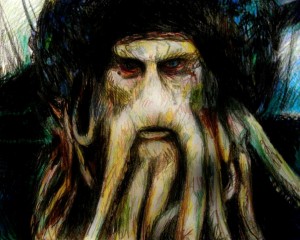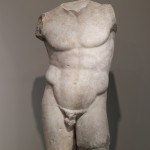We spent this past week in Florida with family. We went to the beach, which I always love. My wife and kids always pull the most interesting things out of the ocean. But this trip was a little unusual in that everything they pulled out was … disgusting. It looked like a collection of props from the movie Aliens, all tentacles and slime. I wish I knew more about aquatic flora and fauna, because words fail to describe some of the things they discovered, both living and dead. A spiney purple sea urchin, its three horned beak still opening and closing slowly. Some kind of grey slimy tubular thing, plant or animal I could not say. A small, overturned insect-like crab, its legs still stretching in the air. A blood-red sea weed that reminded me of something from Speilberg’s remake of War of the Worlds. (We returned everything we found to the ocean.)

My wife pulled this (still living) giant clam out of the water. It was covered in a profusion of the remnants of various life forms. It was both repulsive and beautiful.
“That’s disgusting,” I told her.
My wife held it up to me and said, “This is your Goddess.”
“It’s the slimy side of her,” I responded, making a moue.
I was thinking of what Camile Paglia wrote in Sexual Personae about the way we deceive ourselves about nature’s beauty:
“We say that nature is beautiful. But this aesthetic judgment, which not all peoples have shared, is another defense formation, woefully inadequate for encompassing nature’s totality. What is pretty in nature is confined to the thin skin of the globe on which we huddle. Scratch that sin, and nature’s daemonic ugliness will erupt.
“Our focus on the pretty is an Apollonian strategy. The leaves and flowers, the birds, the hills are a patchwork pattern by which we map the known. What the West represses in its view of nature is the chthonian, which means ‘of the earth’–but earth’s bowels, not its surface. […] The Dionysian is no picnic. It is the chthonian realities which Apollo evades, the blind grinding of subterranean force, the long slow suck, the muck and ooze. It is the dehumanizing brutality of biology and geology, the Darwinian waste and bloodshed, the squalor and rot we must block from our consciousness to retain our Apollonion integrity as persons.”
“This is your Goddess,” my wife said to me smiling.
“It’s the slimy side of her,” I responded.
“This is life,” she replied.
It’s strange when a seemingly mundane moment is transformed into a sacred one. I looked at my Mormon wife standing in the ocean, holding a shell, and I heard her speak the words of a true priestess: “This is your Goddess. This is life.”
I looked out at the ocean, and for the first time it really hit me how much life there is there. While we crawl along the surface of the dry earth, imagining ourselves kings of the planet, the real action is going on under the surface. I imagined if aliens came to our planet, seeing it for the first time, they would likely consider the ocean, not the land, the locus of life, and we humans and all our mighty creations would seem to be a virulent strain of skin cancer in relation to the rest of the life on the planet.
To give you an idea, there are over 57 million square miles of land on earth, which is less than a third of the surface area of the earth. Every schoolchild knows that water covers two-thirds of the earth’s surface. But that’s just the surface. The volume of the ocean is over 300 million cubic miles. Imagine how much life we can pack into a square mile, and that’s mostly two dimensional. (Skyscrapers do give us some vertical space, but the tallest skyscrapers are only about a half mile and they are very rare.) The ocean fills 6 times that in every direction. And even a drop of ocean water is teeming with life. By some estimates there are a million marine species. The idea is enough to make one feel what Teilhard de Chardin called “the distress which makes human wills founder daily under the crushing number of living things and stars.”

Looking at all the slimy things my wife and kids pulled from the sea that day, I realized what an illusion my nice, neat world is. And that includes my neat and pretty spirituality. There is a tendency in Pagan discourse (my own included) to associate the one face of the Goddess with everything pleasant — light, beauty, and life — while everything unpleasant — darkness, ugliness, and death — is the other face. But standing there on the beach, I realized that life and (what I call) ugliness are really the same face.
Camile Paglia writes that repugnance is the “Apollonian” response to the “Dionysian” “grossness of procreative nature.” We recoil from the “chthonian matrix from which we arose. We have an evolutionary revulsion from slime, our site of biologic origins.” She goes on to explain this response in Nietzschean terms:
“Reason and logic are the anxiety-inspired domain of Apollo, premiere god of the sky-cult. The Apollonian is harsh and phobic, coldly cutting itself off from nature by its superhuman purity. […W]estern personality and western achievements are, for better or worse, largely Apollonian. Apollo’s great opponent Dionysus is the ruler of the chthonian whose law is procreative femaleness. As we shall see, the Dionysian is liquid nature, a miasmic swamp whose prototype is the still pond of the womb. […]
“Dionysus was identified with liquids–blood, sap, milk, wine. The Dionysian is nature’s chthonian fluidity. Apollo, on the other hand, gives form and shape, marking of one being from another.”
When Paglia writes about the Dionysian, she is describing the realm of the Goddess. As Edward Whitmont explains in Return of the Goddess, “The disregard of Dionysus is associated also with a disregard and repression of femininity in its archetypal dimension” because Dionysus “is the male expression of visible manifest life which arises from and again returns to its maternal origin.”
The grossness and the vitality of the Goddess are one and the same. This is my Goddess: fecund and fluid, oozing blood, sap, milk … and sea water. All the pretty pictures of goddesses from Bottcelli’s Birth of Venus to the kitchy depictions of goddesses on the internet … these are Apollonian evasions. My Goddess, if she took human form, would be more like a feminine version of one of the tentacled and barnacle-covered pirates from the Flying Dutchman in the Pirates of the Caribbean sequel — perhaps a cross between the repulsive captain Davy Jones and the beautiful sea-witch Calypso. This is my Goddess! Behold her grossness! She is life.













